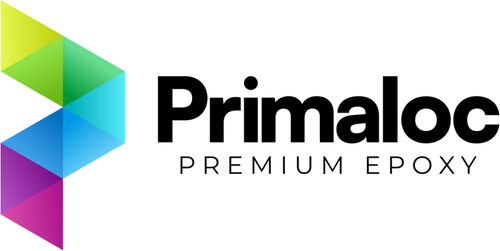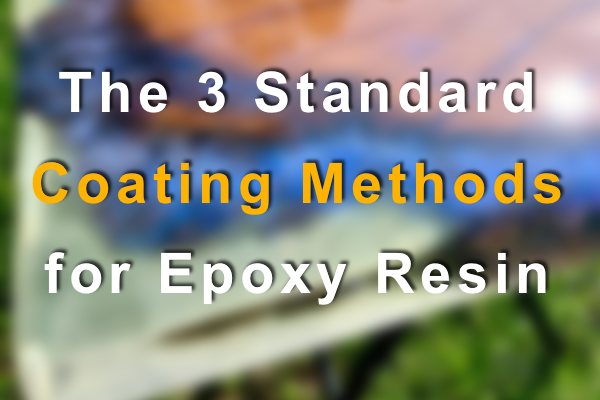If you're a beginner with epoxy resin, you may be unfamiliar with the different coating methods used to ensure a strong and clear epoxy finish. Each of these methods either applies the epoxy in a different way, or uses a different epoxy altogether.
In this article, we explain this methods in detail, so that you can be informed when making decisions about your epoxy projects. These are:
- Epoxy seal coats
- Epoxy flood coats
- Deep pour epoxy coats
While the first two types are commonly found in most epoxy projects—and typically paired together—the third type is specialized for particular applications.
Let's take a look at each type and their specific uses!
The 3 Standard Coating Methods for Epoxy Resin

Method #1: Epoxy Seal Coats
The first coating method employed in most epoxy projects is the epoxy seal coat. This method involves mixing up a small batch of epoxy resin and manually applying it to a substrate (i.e., the surface you'll be coating with epoxy), typically using a clean paintbrush (with firmly attached bristles).
Seal coats are usually the first major step of the project, applied just after you've prepared your substrate and organized your work area.
Why Seal Coats Matter
In epoxy projects, the surface you work on is known as the substrate. This is where the epoxy resin will adhere during the curing process.
Epoxy generally bonds well with porous materials, such as various types of wood, which have tiny holes and indentations that often contain air unless already filled.
When epoxy is applied to these porous surfaces, it tries to fill these small voids before settling on the surface itself. As the viscous resin seeps into the pores, it pushes air out, forcing the air to exit through the epoxy layer itself.
However, the high viscosity inherent to most epoxy resins makes it more difficult for the air to reach the surface and be released, leading to potential air pockets or "air bubbles" within the cured epoxy.
That's why, to prevent this, we recommend applying an epoxy seal coat first. This initial layer is applied with a paintbrush, creating a thin coating that helps expel any trapped air from the pores and establishes a stronger bond for subsequent layers.
A seal coat consists of a light batch of epoxy brushed onto the substrate. It’s just thick enough to penetrate and seal the pores but thin enough to let any trapped air escape. This helps avoid air bubbles when you add heavier flood coats later. Any brush marks from the seal coat will disappear once the subsequent flood coat is applied, provided the timing aligns with the curing instructions.
In some cases, such as with extremely porous materials or when embedding objects into the epoxy, you might need a second seal coat to ensure a flawless finish and optimal adhesion.
Learn more about epoxy seal coats here.

Method #2: Epoxy Flood Coats
The primary coating for most epoxy projects is the epoxy flood coat. This coating made by pouring a large epoxy batch onto the substrate surface, generally after the seal coat (and sometimes deep pour coat) has had time to partially cure. It brings out the iconic smooth, clear aesthetic of epoxy resin finishes.
And fortunately, it's also easy to perform.
Prioritize Durability for Flood Coats
One important factor to flood coating is choosing the right resin for the job. Because a flood coat is generally the final (or only) coating for an epoxy project, it's recommended that users create it using a strong table top epoxy.
Our Primaloc Bar & Table Top Epoxy, for instance, is ideal for this sort of coating, as it boasts the highest durability level and has a viscous, self-leveling nature that allows it to spread consistently on substrates and cure strong.
It also has high cohesion, making it less likely to drip on the floor when conforming to edges and sides of a substrate.
Mix Carefully for a Strong, Clear Flood Coat
Preparing a flood coat batch is straightforward.
You'll start by measuring out your epoxy components in the appropriate ratio and in a suitable mixing container (e.g., 1:1 for our Primaloc Bar & Table Top Epoxy).
Once that's been done, it's time to mix. Mixing methods for epoxy resin vary slightly by how much is being prepared. For batches of less than a gallon, manual mixing using stir sticks alone is generally preferred, as a power drill tends to apply too much force, which can pull in air to produce air bubbles in the epoxy.
For batches of a gallon or larger, though, using a power drill with suitable mixing bit can make the process easier and more efficient, allowing you extra time to apply the epoxy afterward.
Pour the Batch Deliberately
Once you've finished mixing your flood coat batch, it's time to pour it.
Working time—i.e., how long you have to pour it without issue—varies by epoxy type, ranging from 5 minutes for a strong table top epoxy to 30 minutes for a deep pour epoxy. It's best to start immediately after mixing.
The best way to pour is to carefully tilt the mixing container over the substrate from a height of a few inches above. The goal is to spread the epoxy coating across the entire substrate surface, fully enveloping it in the epoxy layer so that it can protect the entire surface after curing.
A good table top epoxy will self-level, spreading out to its natural thickness, then curing; you can assist this spread by guiding the pour over areas of the substrate surface that aren't yet covered.
It's possible to apply too much and cause the epoxy to drip onto the floor. As such, we recommend covering your nearby surfaces with painters plastic to catch any epoxy resin and keep cleanup at the end of your project simple.
One Flood Coat Is Enough—Most of the Time
A single flood coat layer is enough for most epoxy projects. This includes high-traffic pieces like bar tops, table tops, and even kitchen countertops. Most table top epoxies are self-leveling, but the thickness they level to varies by how they're made. Many of these resins self-level to 1/16 inch in depth, which is considered thin by many users, prompting them to apply an additional layer on top for added protection.
Premium table top epoxies like our Primaloc Bar & Table Top Epoxy, however, tend to self-level a more ample 1/8 inch, providing a strong reliable finish that is highly unlikely to be permeated by wear and tear.

Method #3: Deep Pour Epoxy Coats
A deep pour coating is an extra thick layer of resin that can be made using our Primaloc Deep Pour Epoxy, which has a lower viscosity rating than typical epoxy resins.
Unlike viscous table top epoxies, a deep pour resin will flow smoothly, which makes it easier for air to escape from within the resin coating. It's also excpetional at filling in tiny gaps and grooves
In fact, our Primaloc Deep Pour Epoxy supports individual layers of up to 2 inches deep, while still being able to release air for a clean, clear finish.
Keeping Deep Pour Resin Where You Need It
One of the side effects of using a low-viscosity epoxy is that its ability to flows easily means that it can run right off the substrate surface and onto the floor, if it isn't contained.
Because of this, we recommend you construct a temporary dam or use raised edges/railings for your epoxy project. Any of these things will keep the epoxy contained to the substrate surface until it cures enough to bond in place.

The "River" in Most River Tables
Deep pour coatings are commonly performed in the creation of river tables. These are table tops which have one or more deep veins of epoxy—typically tinted with pigments—which run beneath the topcoat surface, and it's deep pour epoxy that does the job best.
Because river veins are usually thick and deep, a deep pour resin is more suited for its ability to release air into the atmosphere so that users can achieve is crystal-clear coating before moving onto the flood coat of their project.
One Downside: Reduced Durability
Deep pour epoxy's greater fluidity comes at a small cost to its overall durability. Compared to table top epoxy, it has slightly lower resistance to physical forms of damage, and its finish isn't quite as tough as the table top epoxy.
Thus, for any project that expects high usage or the potential for physical damage, we recommend a full topcoating of Primaloc Bar & Table Top Epoxy to finish up your project.
Primaloc Epoxy: Premium Epoxy for Premium Results
With our premium Bar & Table Top Epoxy and our Deep Pour Epoxy, Primaloc gets the job done. Our epoxy resins are premium-grade, with high performance in every category, including:
- Unmatched Strength: A Primaloc finish won't buckle, even under high pressure.
- Long-Lasting Resilience: Primaloc epoxy lasts for many years with minimal care, and can endure high-traffic environments with ease.
- A Crystal-Clear Coating: With its pristine, transparent appearance, looking at a cured Primaloc coating is like peering through a window.
Epoxy resin can be beautiful, strong, and long-lasting—which is why you shouldn't compromise on quality. With Primaloc Epoxy Resin, you get the ultimate finish in durability and visual appeal.
Protect your surfaces by giving them a rock-solid epoxy finish. Choose strong. Choose reliable. Choose Primaloc.

